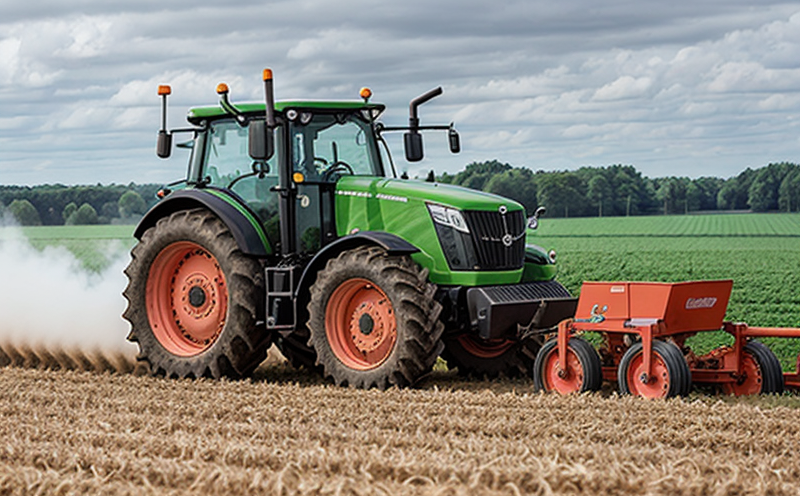Feed Grinder Particle Size Testing
In the realm of agricultural machinery and equipment testing, ensuring optimal performance is crucial. Feed grinders play a vital role in the livestock industry by breaking down feed into manageable sizes that are easily digestible for animals. The particle size of the ground feed directly impacts animal health, digestion efficiency, and overall farm productivity. Testing the particle size is therefore an essential component of quality assurance.
Feed grinder particle size testing involves measuring the distribution of particle sizes in ground feed samples to ensure they meet industry standards and specifications. This process is critical for maintaining consistent product quality and ensuring that livestock receive the nutrients they need efficiently. The testing can be conducted using various methods, including sieving techniques, laser diffraction, and image analysis.
Accurate particle size distribution is important because it affects feed intake rates, rumen digestion times, and overall animal performance. For instance, very fine particles may pass through the digestive system too quickly, leading to reduced nutrient absorption, while excessively large particles can be difficult for animals to chew and digest properly.
Proper particle size testing ensures that feed manufacturers adhere to quality standards set by organizations such as ISO 13320:2009, which provides guidelines on the terminology, principles, and methods of measurement for particle size analysis. By adhering to these standards, laboratories can provide reliable and repeatable test results.
The testing process typically begins with sampling the feed material according to ISO 6473-1:2008, which outlines procedures for sampling solid materials. The sample is then prepared for testing using appropriate sieves or other methods suitable for the particle sizes being measured. Once the sample preparation is complete, it can be analyzed using advanced instrumentation such as laser diffraction analyzers or image analysis systems.
| Sampling Method | Preparation Steps | Analytical Technique |
|---|---|---|
| Sieving Technique | Grind feed sample to a consistent size, pass through sieves of different mesh sizes. | Weigh retained material on each sieve. |
| Laser Diffraction Analysis | Create a suspension of the ground feed in water or another suitable medium. | Measure light scattering patterns to determine particle size distribution. |
The results of these analyses provide detailed information on the distribution of particle sizes within the sample. These data are then used by quality managers and R&D engineers to make informed decisions about process adjustments, ingredient selection, and product development. This ensures that feed products meet both regulatory requirements and customer expectations.
International acceptance of test results is crucial for ensuring consistency across borders and compliance with global standards. Laboratories that perform these tests must adhere to recognized international standards such as ISO 13320:2009, which provides a framework for particle size analysis in various industries including agriculture.
International Acceptance and Recognition
- ISO 13320:2009 – Terminology, principles, and methods of measurement for particle size analysis.
- ASTM D5837-14 – Standard Practice for Particle Size Analysis by Image Analysis.
- EN 16268-1:2015 – Particle size distribution determination by sieving method.
The international acceptance of particle size testing results is achieved through adherence to these standards. Laboratories that comply with these guidelines ensure their test results are valid and reliable, which enhances credibility and trust among clients worldwide. Compliance also facilitates trade between countries by ensuring consistent quality in agricultural products.
Environmental and Sustainability Contributions
The efficient grinding of feed not only benefits animal health but also contributes positively to environmental sustainability. By optimizing particle size, less feed is wasted during the digestion process, reducing waste output and minimizing environmental impact. Additionally, using efficient equipment and processes reduces energy consumption, contributing to lower carbon footprints.
Furthermore, by ensuring that feed meets strict quality standards, laboratories contribute to more sustainable farming practices. This leads to healthier livestock populations, which in turn produce less waste and require fewer resources for maintenance and care. The use of advanced testing methods also supports continuous improvement in agricultural machinery design and operation, fostering innovation in the sector.
Use Cases and Application Examples
| Use Case | Description |
|---|---|
| Farm Animal Nutrition | Determining the optimal particle size for different types of livestock to enhance digestion and nutrient absorption. |
| Poultry Industry | Ensuring feed is ground appropriately to prevent clogging in feeders and improve bird health. |
| Dairy Farms | Optimizing particle size for efficient rumen digestion, leading to higher milk production. |
These applications highlight the importance of precise particle size testing in various agricultural settings. The use cases demonstrate how accurate tests can lead to significant improvements in animal health and productivity, ultimately contributing to more sustainable farming practices.





